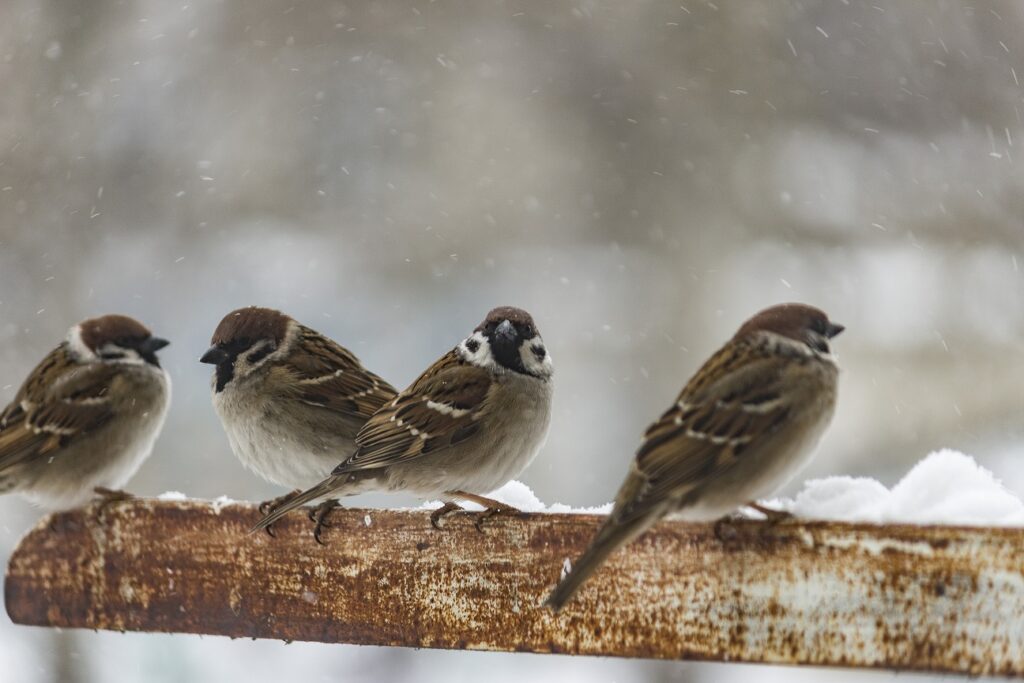 What Happens To House Sparrows In Winter?
What Happens To House Sparrows In Winter?
There are many different species of sparrows in the US, but the house sparrow is the most widespread. These little brown birds are also most often found to be in conflict with humans. They happily live in towns and cities as they are very adaptable and skilled at taking advantage of the opportunities we provide to them.
Keep reading to learn more about the habits of house sparrows in the winter and the conseqences of their cohabitation with humans.
How Do Sparrows Survive The Winter?
During the cold months, house sparrows find their way into all sorts of man-made habitats. We create perfect habitat for them and they thrive on the shelter and food we supply.
The house sparrow stays all winter in the US. These birds may occupy their old nesting sites from previous years, establish new ones, or take over their chosen sites before the arrival of migrating birds in spring, and even usurp nests that the migrating birds have built.
In winter, house sparrows feed on a huge range of foods, from various types of seeds and grains, to discarded food scraps and agricultural crops.
Do House Sparrows Nest In Winter?
House sparrows will most likely build their nests between February and May, and use them throughout the year. In spring and summer, the nest is used to raise young, while in fall and winter, it serves as a place to rest and sleep.
Typically, the nesting season starts in April and lasts until August, but nesting may continue in other months, too.
Where Do Sparrows Nest In Winter?
House sparrows like to make their homes in, on, or near buildings. They prefer to nest in cavities, hollows, dryer and other vents, attic vent louvers, and crevices such as around window-mounted AC units.
Also, awnings, street signs, eaves of the roof, or underneath tiles are their favorite nesting locations.
Wherever they find some space to squeeze in and can make the most of the shelter, house sparrows will move in. They can also take over other birds nests.
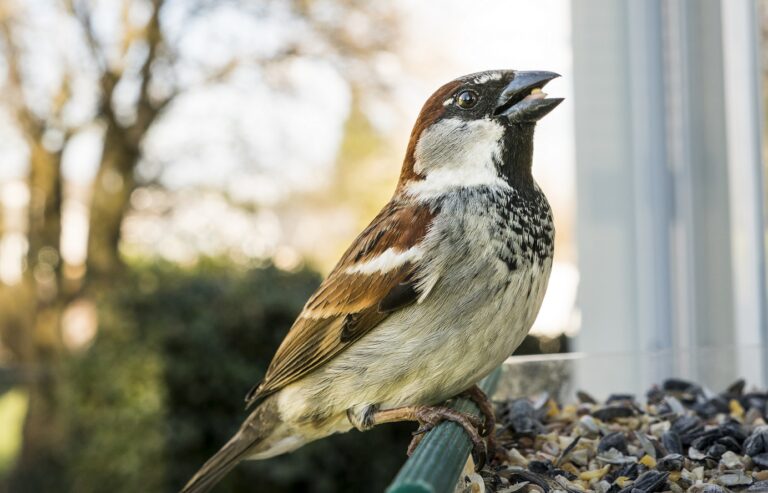
What Problems Do House Sparrows Cause?
Despite their small size, house sparrows are very aggressive. They can cause many problems for native birds as they will attack, harass, and kill them when competing for nesting sites. Sparrows can also destroy their eggs and hatchlings, and take over their food sources from bird feeders.
While on your property, it is only the manner in which these birds accommodate themselves in your home that can cause a problem for you.
Like all birds, sparrows have the ability to cause significant damage to your house, both outside and inside. They seek shelter in enclosed or protected areas and like to build nests that are large and act as a link for their colony and activities.
Their habit of stuffing nesting material in dryer, stove, and fan vents may cause the vents not function properly and prevent further use of the vents, which is a more serious problem.
In addition, sparrows nesting in your house structure could result in the following:
– Damage to roof tiles. Nesting sparrows can dislodge the tiles.
– Bird droppings. Their feces can carry harmful diseases.
– Filthy, unhygienic waste and foul odor. Their old nests may contain rotten eggs and decaying chicks that failed to survive.
– Insects and pests. The material they use to build nests can contain insects and other small pests that can then find their way into your attic and home, causing more problems for you.
How Can You Keep Sparrows Away From Your House?
Therefore, getting rid of house sparrows and their nests from places you don’t want and preventing these birds from building new nests in your house, is the first and best approach.
For this, it’s good to install covers over vents to keep sparrows and other birds out, and check screening over louvers before the birds make their way in. Exclusion methods are particularly useful, such as nets, sheet metal, or hardware cloth in order to block any openings that could serve as potential nesting areas. You may use various deterrents or tactile gels that help prevent roosting and perching.
Always remember to remove the nesting material and make sure that there are no chicks present in the nest before excluding the birds.
If you notice sparrows, or any other nuisance birds nesting or flying on your property, it’s best to have them eliminated immediately.
If your home is located in one of our service areas of Westchester, Dutchess, and Putnam Counties, NY, or Fairfield County, CT, reach out to us for help with our bird removal services. Westchester Wildlife is a top-rated bird removal company in your local area.
Call us today to schedule a bird removal inspection and get a quote with a member of our expert wildlife control team.
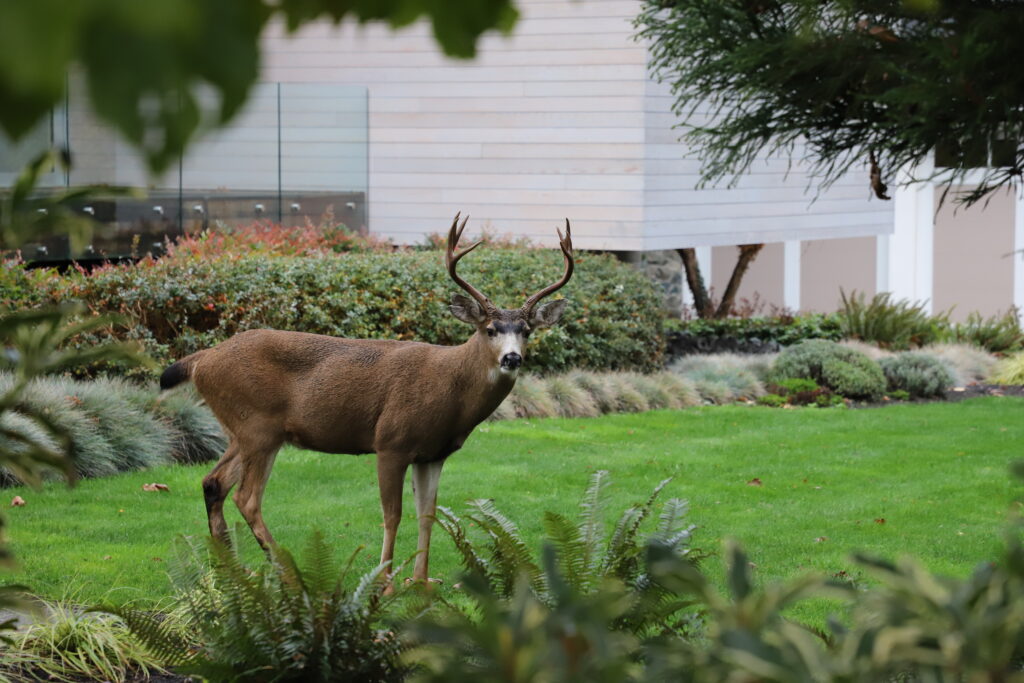 Can Noises Scare Deer Away From Your Yard?
Can Noises Scare Deer Away From Your Yard?
Deer are majestic animals that are pretty to look at if you manage to catch a glimpse of them galloping through the forest. But they can quickly turn into an invasive pest once set loose in your yard. They will destroy your tender crops, leaving plenty of vegetation damage.
This wildlife doesn’t gather and store food for winter, but consumes whatever is available throughout the year. In winter, deer feed on the lower branches of evergreen trees and shrubs, while in summer they forage mainly on garden crops such as tomatoes, lettuce, bulbs, and flowers.
Keep reading as we share a bit of insight into their habits, which you may take advantage of to keep deer out of your property and save your garden from becoming a free buffet.
The best starting point for keeping nuisance deer away is to use scare tactics. There are plenty of ways to deter deer but the perfect place to start is by using sound and targeting their sense of hearing. Try to frighten them using loud noises or whistles, just be careful not to disturb your neighbors.
Are Deer Scared Of Noises?
Deer are shy and skittish but also smart and highly adaptable animals, so you must skillfully target their senses if you want to keep your yard safe from deer.
Their ability to distinguish between natural and unnatural noises in the forest gives them an advantage. Most loud noises that are not the usual everyday sounds of wild animals, will startle deer. Anything that’s unfamiliar to them can throw them off and make them too nervous to come near.
These creatures have funnel-shaped ears that are designed to pinpoint the source and exact direction from which the sound is coming. And it’s not only an advantage for them, but it also allows homeowners to use the precision of deer ears to deter them from the yard and garden.
What Noises Are Deer Scared Of?
If you have a really persistent deer turning your garden into its next feeding spot, using noises as deterrents might work for you.
They will be afraid of loud, banging noises, yelling, or barking dogs. To keep deer from ravaging your property, try using auditory deterrents such as bells, whistles, radios, alarms, and ultrasonic devices to scare them away when you notice them. Introduce motion-activated devices that create startling sounds, preferably in combination with movement or bright light.
Scare deer off before they do too much damage in your yard. Use metal cans, pie pans, or wind chimes suspended by strings as they make noise when they rattle in the wind.
Pinwheels can also repel deer with their noise when they’re attached to branches, fences, or dowels around your yard. The noise, movements, and colors should be enough to startle any deer, at least until it learns there is no real threat. Noise-making deterrents like gas or propane exploders produce loud noises that frighten deer away, and have been used to help protect gardens and crops.
In addition, deer are known to hate ultrasonic pest control devices as they emit high-frequency sounds. Such repellents are a humane and noninvasive option to get rid of deer. Some devices even combine ultrasonic technology with motion sensors and lights, and they work best.
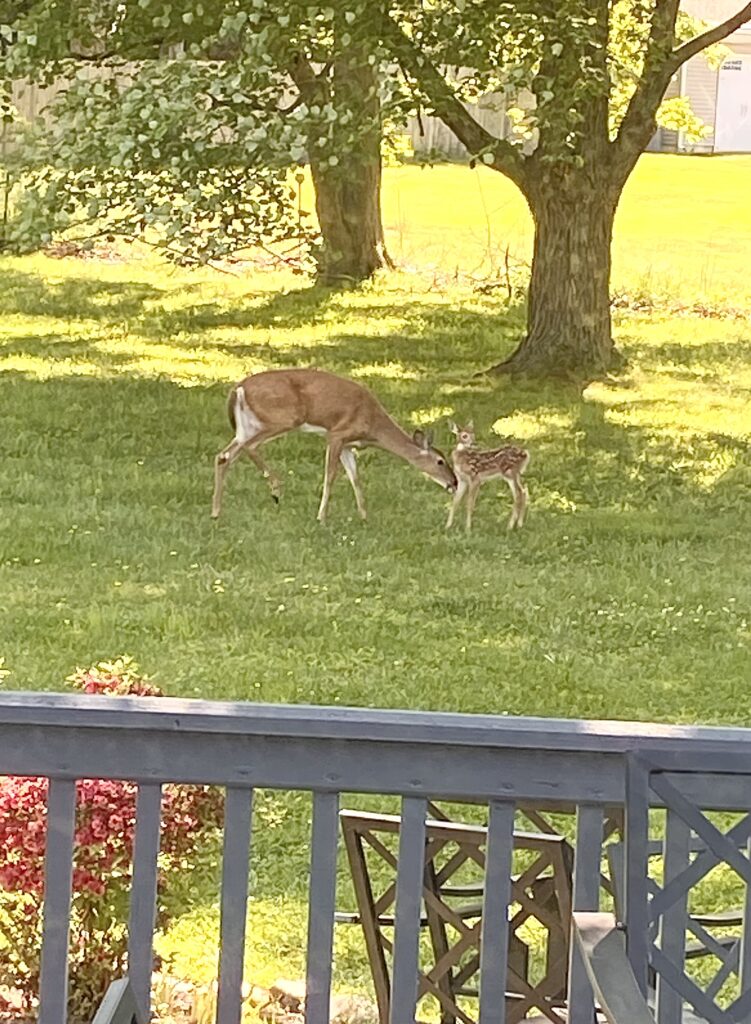
What Frequency Scares Deer Off?
Ultrasonic devices work on deer as these animals are able to hear ultrasonic sounds. Deer can hear at almost the same frequencies as humans, but they are better at determining the direction and cause of each sound they hear.
They can hear high frequency soundwaves, between about 250 and 30,000 hertz, which means they can hear tones that are well above what humans can detect. Their hearing however is most sensitive to moderate frequencies, from 4 to 8,000 hertz. A frequency of 15-25,000 herz is still silent to most people, but it can successfully repel deer from your yard.
Will Deer Come Back After Being Spooked?
Spooked deer will come back to their bedding area, but how soon they return depends on how much something has frightened them. If they can’t identify any danger, they won’t hesitate and will return sooner than if they saw or sensed a human.
On the other hand, the loud noises you use to scare them off will definitely work, but keeping this wildlife away is the hardest part. If they find food scarce in winter, or they liked the veggies you grow in your garden and they designate your yard as their feeding ground, they will be back again.
So if you plan on using sound to keep deer out of your yard, it is advised to change your strategies frequently. These animals can easily adapt to new methods of deterring them, which makes you work overtime to ensure the safety of your property.
Are you experiencing constant problems on your property with wild animals such as deer? To protect your garden and lawn from deer damage, droppings, and mess, it is best to get professional help by contacting a wildlife control specialist.
Westchester Wildlife company can help you choose the right strategy to prevent deer from destroying your garden or yard. You can rely on our wildlife removal and control services, whether you live in Fairfield County CT, or Westchester, Putnam, and Dutchess Counties NY. What’s more, at Westchester Wildlife we are focused on humane and least stressful methods of wild animal removal. So call us today!
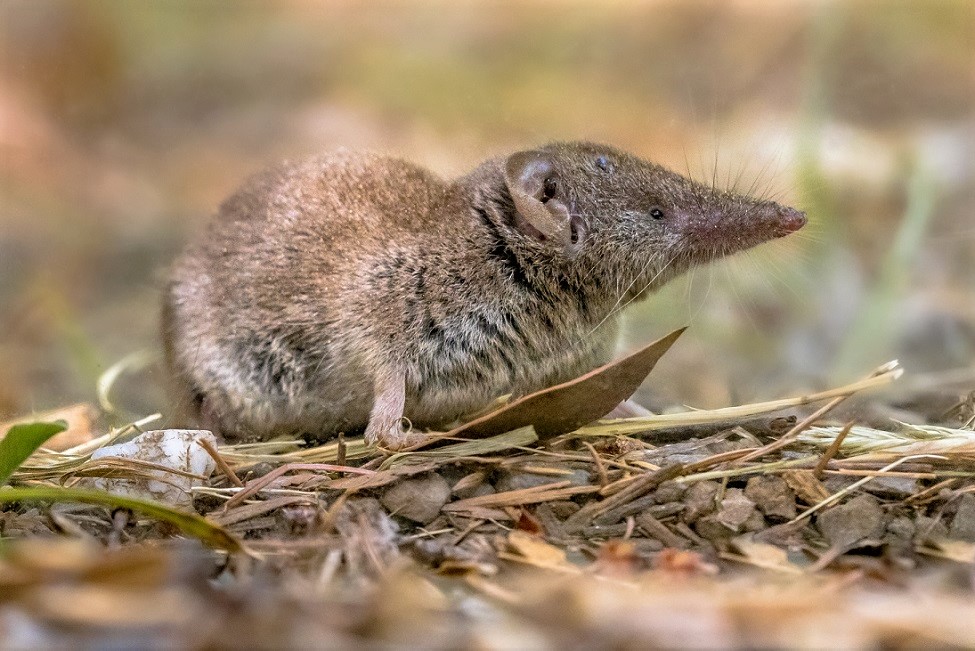 Does A Shrew Make Noise?
Does A Shrew Make Noise?
If you’ve never had a problem with shrews on your property, you will think these tiny mouse-like animals scurrying around are cute. But when a lot of them show up in your home or yard, they quickly become not so cute, especially when you realize that their bites are actually quite venomous.
Shrews are very vocal mammals. They make a lot of noise as they go about their daily routine. When they get into your home where you can hear them all the time, you will soon grow to hate their sounds.
Therefore, if you spot a shrew in your house or yard, you must act promptly to get rid of it. Keep reading to learn in detail about the sounds that shrews make and how to recognize them.
What Kind Of Sounds Do Shrews Make?
Shrews are noisy little creatures that have a diverse repertoire of communication sounds. Their vocalizations are their way of communicating.
By nature, unlike bat sounds, the shrew sounds are low-amplitude, multi-harmonic, broadband, and often modulated.
They make a range of squeaking and chirping calls, as well as faint high-pitched laryngeal twittering calls. Shrews also emit sounds such as clicks, hisses, churls, whistles, barks, buzzes, and short screams.
Shrews usually run along, making short ‘brrrrr’ noises. However, during the wintertime, you won’t be able to hear them that much in the snow on the ground.
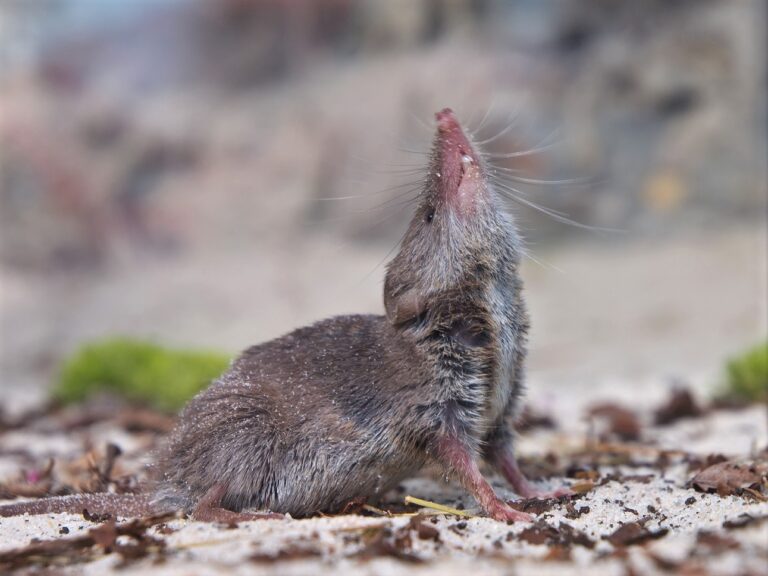
Why Do Shrews Make Noise?
Since shrews are active both during the day and night, you will usually be able to notice the noises they emit. They communicate with a series of different sounds such as squeaks and clicks.
However, just like bats, shrews also make very high-pitched sounds that are beyond the range of human hearing. Especially if you’ve lost some of your ability to hear high frequencies, you may struggle to hear some of their sounds.
High-pitched sounds serve for communication purposes, to converse and communicate within families, and for interactions between mother and young.
Just like bats, shrews use an echo‐based orientation system. But it is simpler, and instead of using it for finding food, they use it to explore their surroundings.
Shrews are animals digging in the ground, so they need to produce a variety of sounds to communicate, navigate, and locate objects and other obstacles in their tunnels. When moving about, especially in new places, they find their way by making high-pitched twittering sounds that bounce off of their nearby surroundings. Their calls are for identifying routes through the new environment, for obtaining information from their surroundings, and for probing habitat types. These are ultrasonic sounds that are emitted for echolocation purposes.
Besides the ultrasonic echolocation sounds made by shrews, there are several other sounds that humans are able to hear, especially when these pests are being territorial. Because shrews are very territorial and aggressive, they can sometimes be heard fighting, and their squeaks and chirps are particularly noticeable in the summer.
Their loud sounds can show fear and aggression when fighting or interacting with other individuals. They also act as an alarm to defend themselves, ward off potential threats, and when the animal is panicking and feels threatened.
Other shrew sounds such as clicks, may occur during courtship. Male shrews will make these noises to attract and court females.
Up to 17 different types of calls have been identified, suggesting that shrews need to communicate something on a regular basis. Otherwise, if they make too much noise for no apparent reason, they risk being found by predators and eaten as they are tiny animals. Most often, the shrews make noise when they are encountering other animals or marking their territory with calls.
Meanwhile, some shrews can be heard making repetitive, low, squeaking noises while they’re lying still in their nests on their own and doing absolutely nothing.
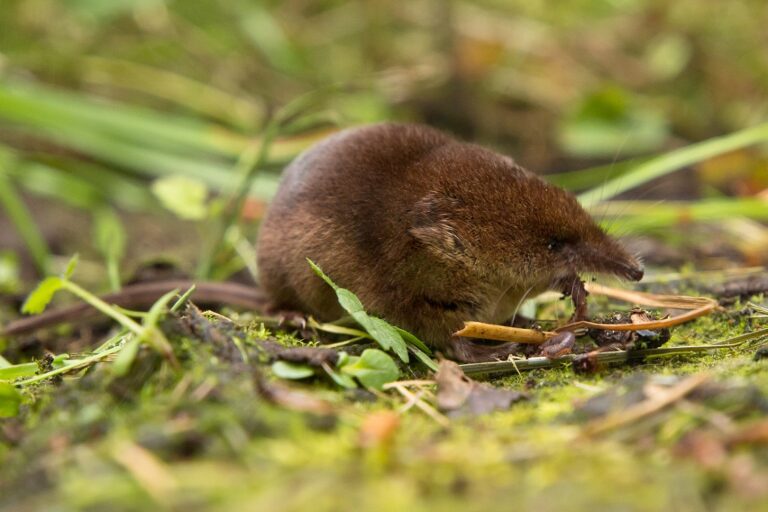
If you frequently hear or notice small creatures running around your landscape, you might have a problem with shrews. Keep in mind that controlling shrews can be a challenge for homeowners, therefore implementing an integrated pest management approach, along with methods such as trapping, baiting, and habitat modification can guarantee the best chance of success.
If you’ve been experiencing issues with shrews on your property, you might need professional help with your shrew trapping and removal. Give our Westchester Wildlife team a call, whether you’re located in Westchester County, Dutchess County, Putnam County, NY, or Fairfield County, CT.
Our exterminators are highly skilled and knowledgeable, and specialize in a wide range of pest and wildlife control services, including getting rid of shrews. Contact us today and let us know how we can assist you!
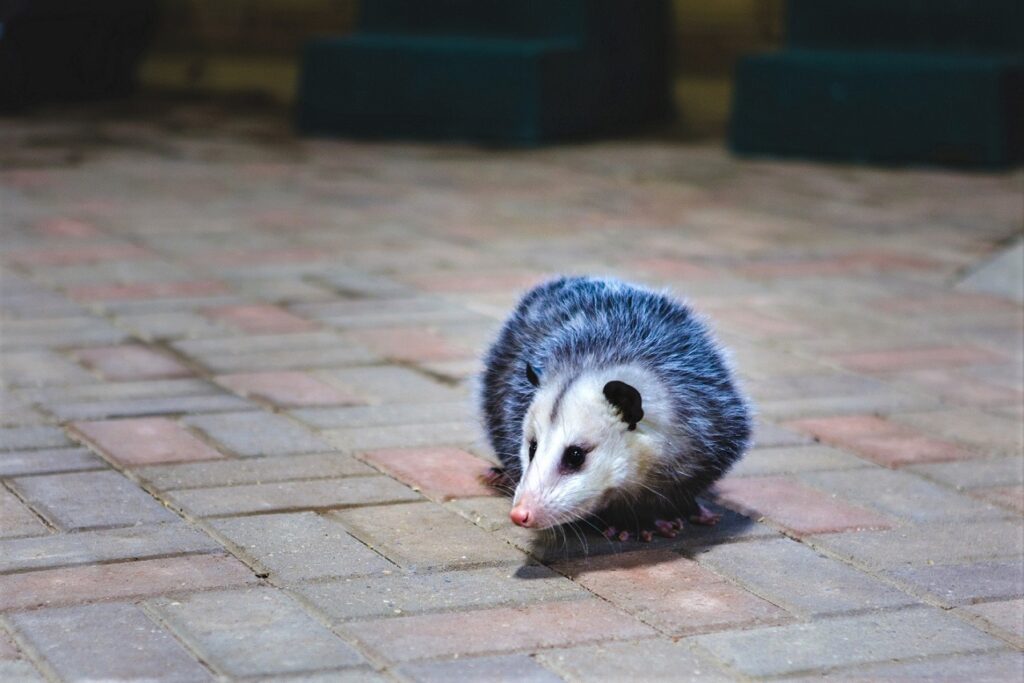 What Attracts Opossums To Your House?
What Attracts Opossums To Your House?
If you keep hearing noises like fast screeching or hissing coming from your garbage can, then it’s likely to be an opossum or one of many other small wild animals. You can frequently find opossums in urban areas as they are used to seeing humans.
Under normal circumstances, opossums will occasionally meander through the yard in search of food and water, before moving on somewhere else. This is how they end up in your house. Typically, these animals don’t stick around for too long, unless the female makes your home her home for her newborn babies.
Opossums are nocturnal creatures that come out shortly after sunset. This is why you may encounter one, or more of them in your house at night. But that’s not always the case as sick opossums can sometimes be seen in the afternoon as well. Anyhow, these mammals are typically bad news for homeowners and gardeners.
However, opossums are not likely to make their way into people’s homes unless there is an easy entry point and a good reason for them to come in, that is, food, water, and shelter.
Food and water sources are the same reasons why they come indoors as they come to your yard. These are scavengers that like to go around in constant search of food and water, and they will pay return visits to places that offer them what they need. They have an acute sense of smell and are able to pick up the smell of food from far away. So they’ll go around sniffing until they find the source. Therefore, remember not to make your living spaces inviting for opossums.
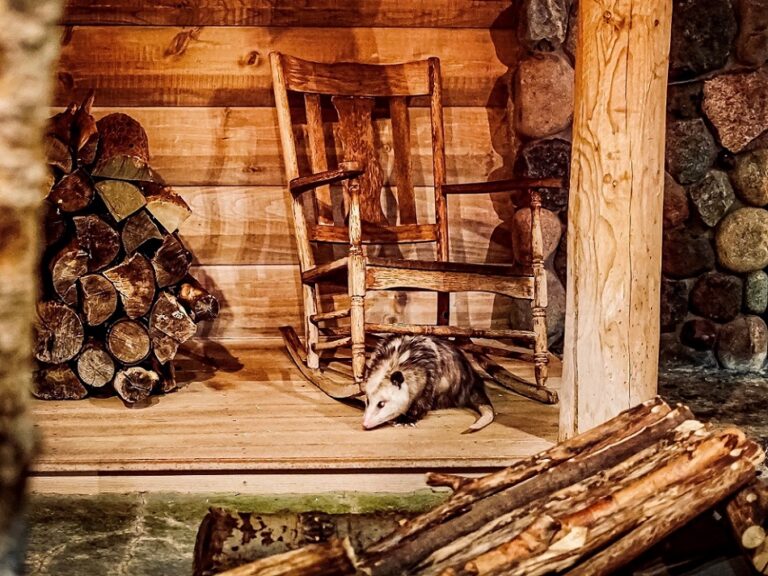
There are a few things that will attract opossums to your house:
Filled Up Garbage Cans
These can definitely attract opossums to your home. A trash can that’s stuffed with all kinds of discarded food is an invitation for opossums to come over. The marsupials will have very easy access to the contents of the bin, if it’s not sealed properly.
Pet Food
You will definitely attract them to make their way indoors if there is a bowl of water and pet food beside the front door. If you’re someone who feeds your cat or dog at the door or outside, then it’s highly possible that an opossum will sniff out the scraps at night.
As these pests lead a nocturnal lifestyle, if the leftover food is not consumed quickly by your pet, or even worse, if it’s left to sit out overnight, you may find that it’s missing by the morning.
Partially Rotten Fruit
Opossums are opportunistic omnivores, and they feed primarily on various plants, insects, and carrion outside, but they will also eat fruits and flowers indoors.
Sweet fruits such as berries, pineapples, or mangos, are their favorites. You might have a bowl of partially rotten pieces of fruit left out on the kitchen table. If you don’t throw them away in time, these little scavengers can pick up the smell and come.
They could have a take on your fragrant pot plants at home, too.
How To Get Rid Of Opossums In Your House?
Once you have identified the culprit, you can now start getting rid of them. If you realize that the opossum is overstaying its welcome on your property, there are some methods to eliminate the problem.
First of all, seal off all entry points, and remember to close and secure pet doors at night. Make sure they don’t find their way inside.
To keep opossums out, turn on the radio or TV, or hang wind chimes. These animals are scared of unusual noises, particularly when they are not sure of the source. But it’s crucial to change the radio or TV station once in a while, and alternate between the wind chimes and radio stations.
Another good way to deal with the opossum on your own, without harming them, is to sprinkle chili powder in various areas of your house. Opossums clearly don’t like the smell or taste of chili powder and will stay away.
Finally, an effective way to get rid of opossums is to set up live traps in and around your house. However, because the trap can only take one animals at a time, using traps to remove this wildlife is only effective when you’re dealing with a single animal. Since opossums are slow creatures that can’t see very well, placing traps around your property makes it easy to get rid of them.
It’s also important to remember that they possess a special skill, which is their ability to play dead. That’s why you should be extra careful when approaching a captured opossum. Even though they don’t usually attack people, opossums are riddled with transmittable diseases, such as tuberculosis, leptospirosis, coccidiosis, or toxoplasmosis. As such, they can be dangerous if they manage to scratch or bite you, or if you make contact with their urine or feces.
If you’re not someone to face an opossum in your house, it’s best to hire a wildlife control expert to handle that for you. The professional will know exactly what to do as they have a lot of experience eradicating wildlife of all sorts.
So don’t hesitate to call your local Westchester Wildlife team, and someone will come out and help you remove the critter. We safely and humanely trap and eliminate wildlife in Westchester, Dutchess, and Putnam Counties, NY, as well as in Fairfield County, CT.
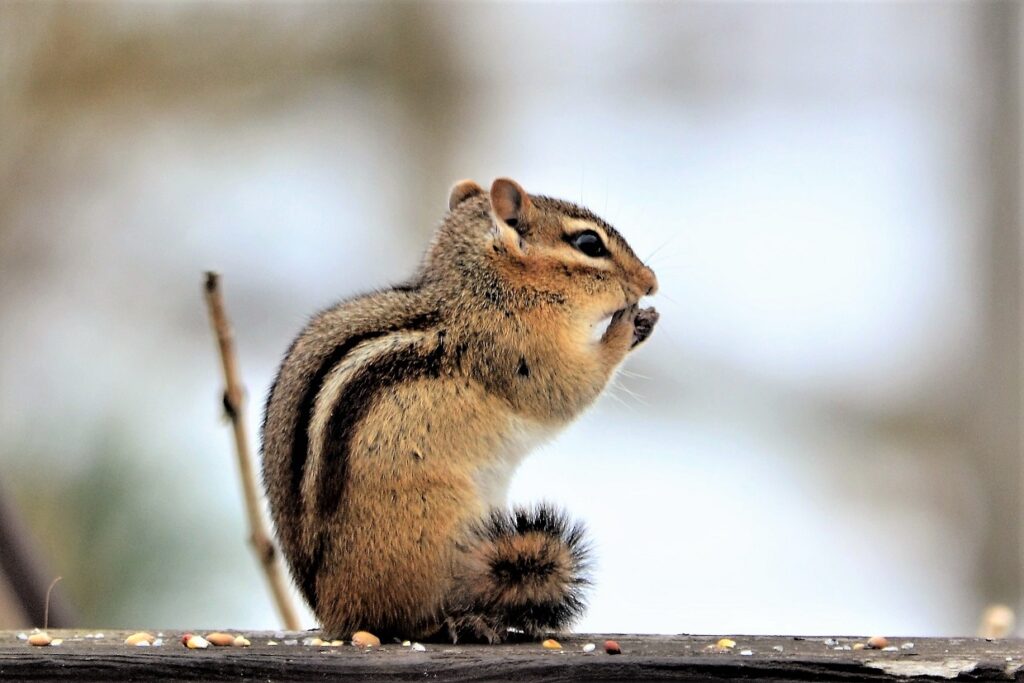 Do Chipmunks Hibernate In Winter?
Do Chipmunks Hibernate In Winter?
Whenever there is cold weather, chipmunks spend most of their time hibernating and simply sleeping or resting in their dens. They are known to be quite occupied, and just one of them will quickly gather up to 165 acorns per day.
In as little as two days, the chipmunk will have managed to collect enough food to take them through the whole winter season. However, they are also known to store up more food than is necessary, so they will typically have collected more than they need for the cold months.
Even though they are known to hibernate during the winter, chipmunks will not be asleep for the entire season as most other hibernators do. They will typically retreat back to their burrows. Occasionally, they wake up to bring their body temperature back to normal.
When they are on these awake breaks, the chipmunks will feed on the food stored over time to build up their fat reserves. This is very important for the cold season aa it allows them to stay protected from the cold. Every few days, the chipmunk wakes up for temperature adjustment, has a few more nuts, and quietly goes back to sleep for some more days.
What Months Do Chipmunks Hibernate?
The typical period for chipmunk hibernation lies between October and the middle of March. This is usually when the weather outside is harsh and the temperatures have dropped to deficient levels.
The chipmunks in the southern parts of the US have better weather, as it is much warmer in these places. As such, they will hibernate for a shorter amount of time, between December and late January. Their bodies also undergo essential changes that enable them to survive the winter.
These are all important as they ensure that the chipmunk can survive the harsh, cold months and get them through safely and as intact as possible. The months of hibernation are generally uneventful, and not many things happen during that time for chipmunks.
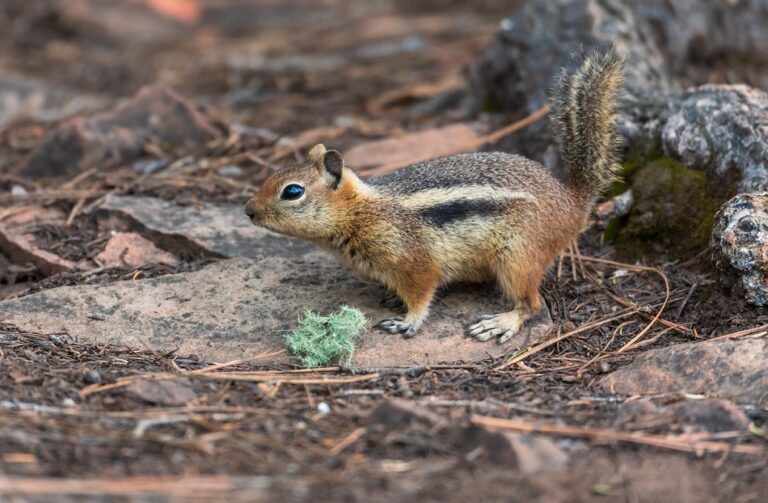
At What Temperature Do Chipmunks Hibernate?
At around 40°F is when the chipmunk starts to hibernate. Once it has gotten cold enough, it will retreat to its burrow to spend the winter.
Other things also happen when the chipmunk is undergoing the hibernation process. These enable them to spend as little energy as possible, and as such, they will easily manage to get through the winter with much ease. For instance, their body temperature will start to lower to match them with their surroundings. As such, they will not lose heat quickly, allowing them to maintain a constant temperature for the rest of the winter.
They will also slow their heart rate down from the usual 350 beats per minute to a mere four beats per minute. This is several magnitudes slower and indicates the changes the chipmunk has to undergo to stay safe and warm for the winter. When their hearts are beating this slow, they can sleep out the rest of the winter and get the rest they have worked so hard for.
Where Do Chipmunks Sleep In The Winter?
The most excellent chipmunk preference is to live alone in an underground hole or burrow, referred to as a den. They like to hibernate when the weather is cold, and this is where they will spend most of their time, staying insulated from the harsh cold temperatures outside.
They are usually relaxed when in hibernation, and most of their body functions are significantly slower to enable them to get through the cold winters. Most of the time a chipmunk spends in hibernation goes to sleep while a portion is reserved for feeding, urinating, and defecating.
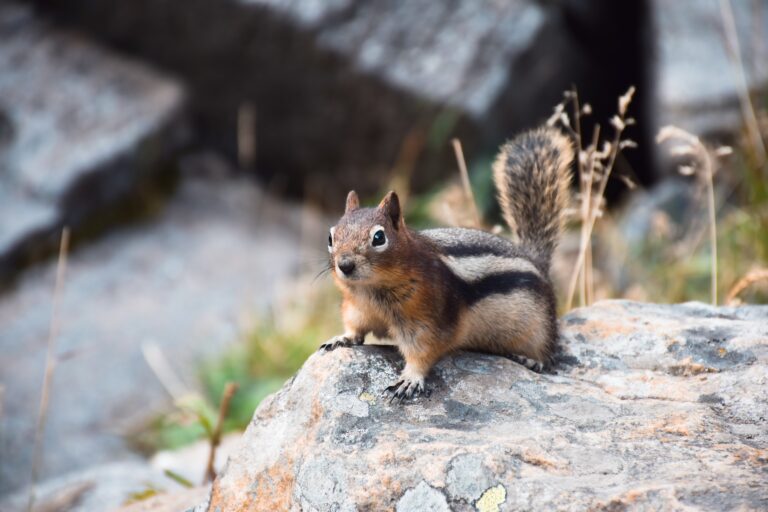
What Do Chipmunks Eat When They Hibernate?
Inside a chipmunk’s den is enough storage space for their nuts and seeds. These nuts and seeds are essential as they are a food source for the chipmunk that lasts through the entire winter. They love to eat and will wake up occasionally to get fed and get the break they need from the enormous amount of rest they have had.
Chipmunks usually gather enough nuts and seeds to eat throughout the winter, which is what the rest of the year is meant for. They are very hardworking creatures and, as such, will work through all kinds of challenges to get the much-needed supplies in storage and ready for the cold winter months.
Our experts are trained to remove all types of nuisance wildlife, including chipmunks. We provide effective trapping and removal services in Westchester County, Dutchess County, Putnam County, NY, and Fairfield County, CT. So if you’re having chipmunk issues on your property at any time of the year, call Westchester Wildlife to get rid of them!
Behavior and Prevention
Rats are medium sized rodents (non-flying mammal) whose origins can be traced back nearly 56 million years ago. Rats are a diverse species but share a common feature: single paired jaw incisors and large jaw. They are active all year round and mate up to four times a year (average litter size of 8, peaking in summer and autumn).
Read moreThe “house mouse” belongs to the rodent family. They commonly dwell in close distance to humans. These small, furry mammals adapt in a variety of environmental conditions and can be found seeking residence (especially in colder months) in homes, commercial structures, and open fields.
Read moreSkunks are widely recognized for their unique black and white striped markings and foul odor they can leave behind. Their notorious defensive mechanism is to spray when threatened.
Read moreIt’s 3 o’clock in the morning. You wake up to something scratching and running around above your head in the ceiling. What can it be? Wait, it sounds like there could be more than one! What are they doing up there…bowling?
Read more
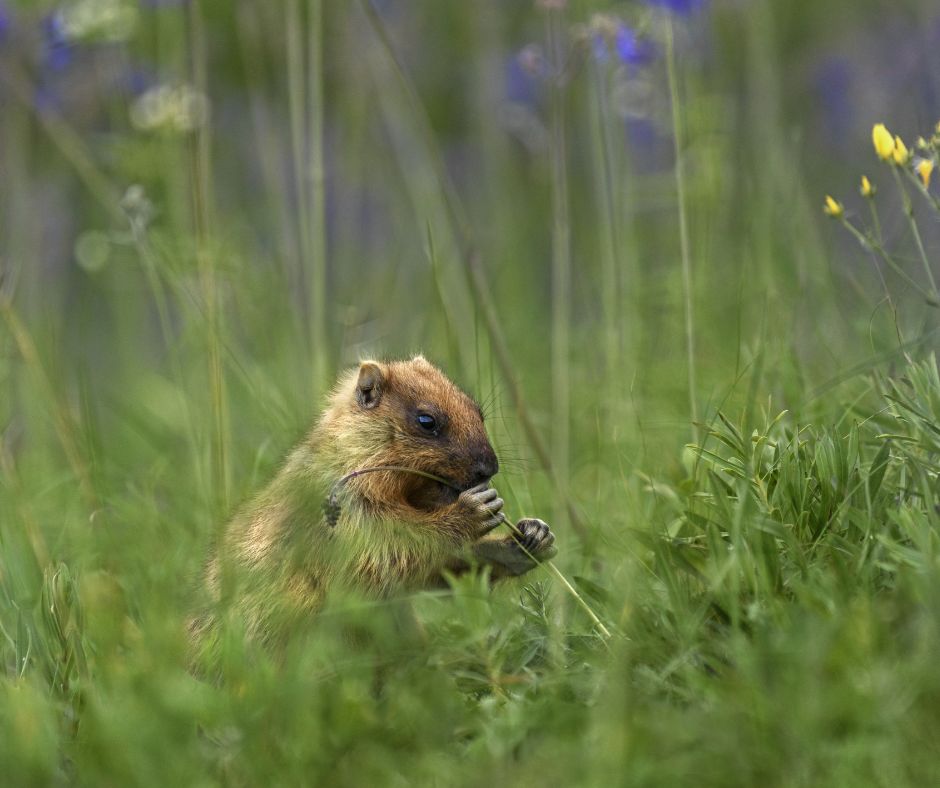
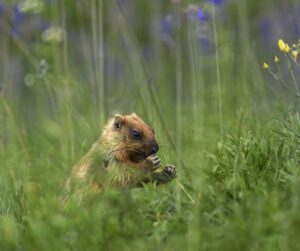
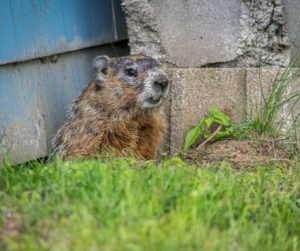 Groundhogs are extremely clever animals that will quickly wizen up to most wildlife harassment techniques, so the most effective method of groundhog prevention is to install wildlife fencing around the areas that you need protected, like a shed, deck, porch or foundation. Wildlife fences can also be installed around the perimeter of the entire yard. Groundhogs are burrowing animals, so making sure these fences are buried at least a foot into the ground is essential.
Groundhogs are extremely clever animals that will quickly wizen up to most wildlife harassment techniques, so the most effective method of groundhog prevention is to install wildlife fencing around the areas that you need protected, like a shed, deck, porch or foundation. Wildlife fences can also be installed around the perimeter of the entire yard. Groundhogs are burrowing animals, so making sure these fences are buried at least a foot into the ground is essential. 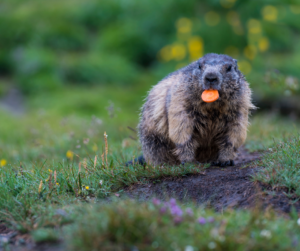 Groundhogs will often dig up and eat the fresh vegetables and fruit from your garden, often killing the plants in the process. If you have a green thumb and take an active interest in keeping up your garden, this can be very frustrating. Thankfully, there are ways to prevent groundhogs from getting inside your garden. Burying a wildlife fence at least a foot deep in the ground around the perimeter of your garden can deter these groundhogs from getting inside. Groundhogs are also drawn to yards with tall grasses and heavy vegetation, so keeping the grass outside your garden cut short and clear of excess plants will keep groundhogs from digging in your yard, as it won’t feel safe.
Groundhogs will often dig up and eat the fresh vegetables and fruit from your garden, often killing the plants in the process. If you have a green thumb and take an active interest in keeping up your garden, this can be very frustrating. Thankfully, there are ways to prevent groundhogs from getting inside your garden. Burying a wildlife fence at least a foot deep in the ground around the perimeter of your garden can deter these groundhogs from getting inside. Groundhogs are also drawn to yards with tall grasses and heavy vegetation, so keeping the grass outside your garden cut short and clear of excess plants will keep groundhogs from digging in your yard, as it won’t feel safe.